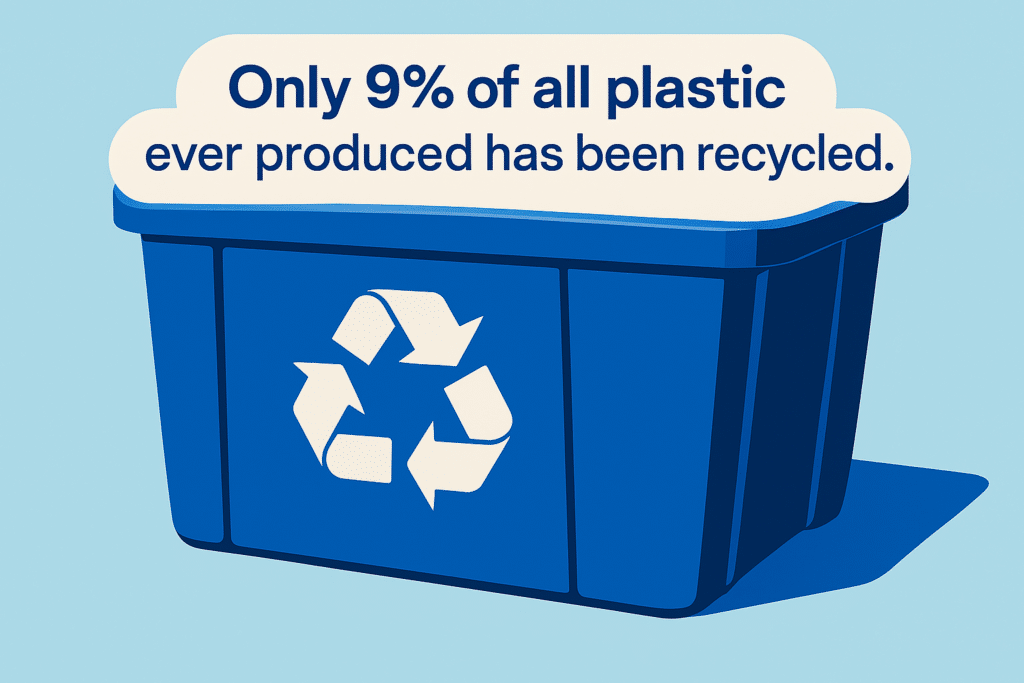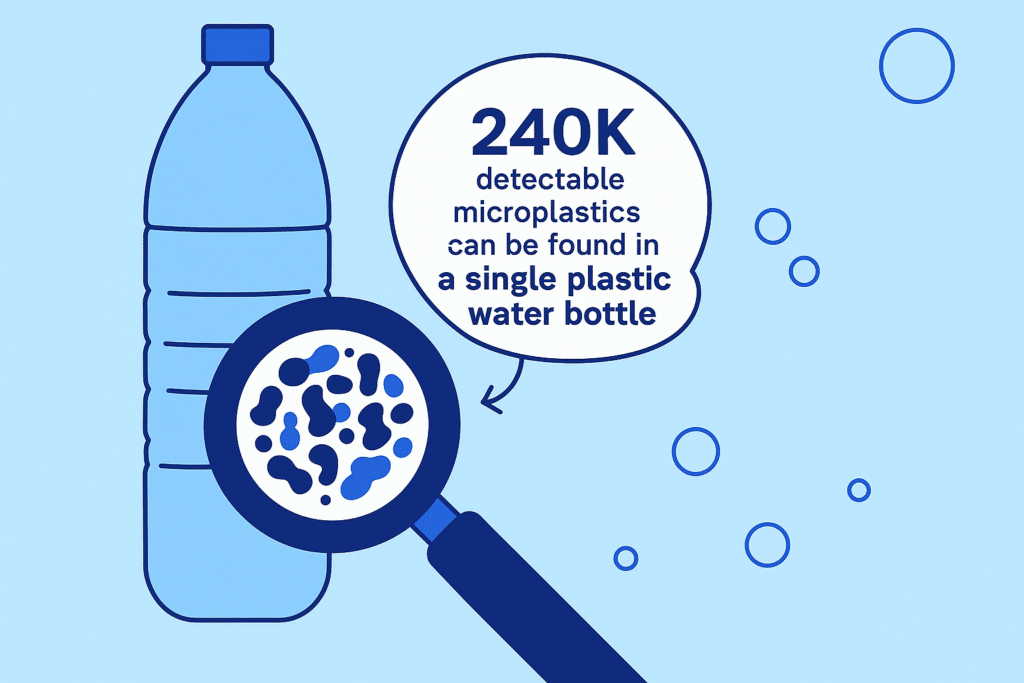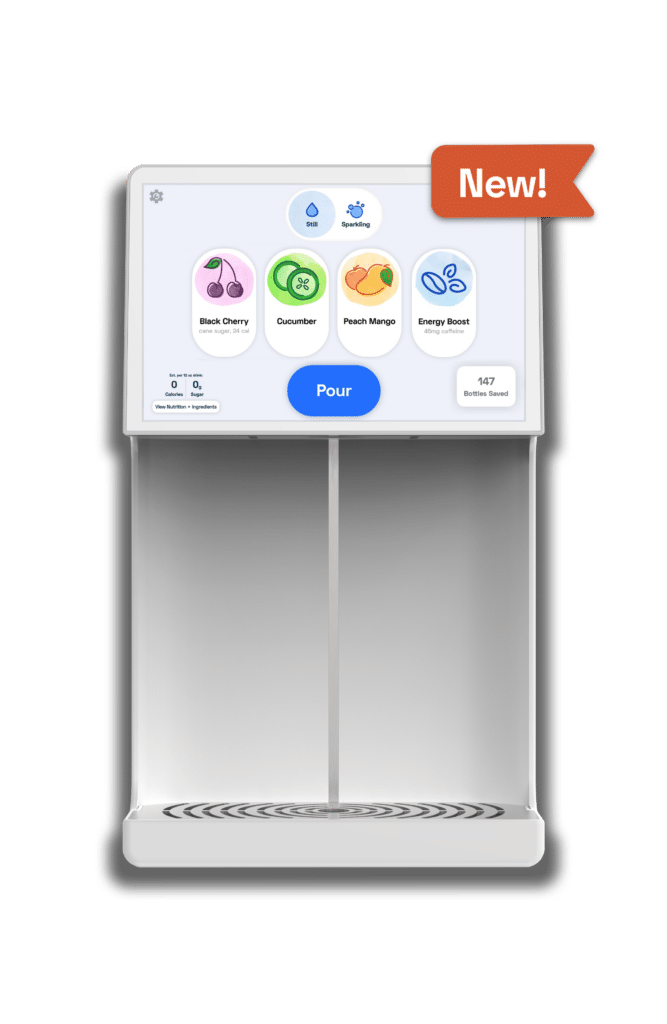Last updated April 22, 2025.
A minute from now, another million plastic bottles of water will have been sold all over the world. Are you buying?
The vast majority of these plastic water bottles will be used only once. Most won’t be recycled. Instead, they’ll be incinerated or forgotten—piling up in landfills, clogging rivers, washing into oceans. And over time, they’ll break down into microplastics that are now showing up inside the human body.
Despite mounting evidence of the environmental and health risks, plastic bottled water sales keep climbing. Why?
- Most people don’t realize how much plastic they’re actually drinking.
- Research into what microplastics do to our health is only just beginning.
- Plastic bottles are cheap to make and easy to move.
- Brands build their identity on single-use packaging.
- Recycling efforts provide just enough cover to keep the system going.
This report was written to show exactly how every bottle counts. It lays out how plastic bottles are made, where they end up, and what they’re doing to our environment and our bodies. It also shows what the alternative looks like when you eliminate the bottle entirely.
What’s below:
- How much bottled plastic the beverage industry is selling
- Why recycling doesn’t come close to solving the problem
- What plastic bottles are doing to the environment
- How plastic packaging is contaminating the drinking water it’s supposed to deliver
There’s already a better way
Bevi machines filter your water to make it the kind of beverage you actually want to drink. Sparkling or still, flavored or plain, cold or room temperature, with or without functional ingredients. No single-use plastic bottles. Just the best water you’ve ever tasted.
Removing plastic, inside and out. Bevi machines not only eliminate the need for a single-use bottle, but also the risk of plastic in your drinking water. They are equipped with advanced filtration that removes 99.9% of microplastics and other common contaminants.*
*when using the recommended 3M HF20-i carbon filter.
An industry built on waste
Since plastic bottles began replacing glass in the 1970s, the beverage industry has built its entire supply chain around cheap, lightweight plastic.
- 600 billion plastic bottles are produced each year for water alone.
- 15.9 billion gallons of bottled water were sold in the United States in 2023.
- By 2050, we’re on track to produce 2.4 trillion pounds of plastic annually.
From manufacturing to transport to disposal, plastic bottles waste energy and create emissions. And once discarded, they become long-term pollutants, whether intact or as microplastics.
The recycling excuse
Ask most beverage brands about their plastic environmental impact, and they’ll point to ambitious recycling goals.
- Coke: By 2035, Coca-Cola aims to collect the equivalent of 75% of the bottles and cans it puts into the market each year in order to recycle them.
- Pepsi: By this year, Pepsi is looking to have 100% of its packaging be recyclable, compostable, biodegradable, or reusable.
- Nestlé: By the end of this year, Nestlé is looking to have 95% of its plastic packaging designed for recycling.
These efforts sound promising. But recycling doesn’t scale nearly fast enough to keep up with this much plastic production. Plus, if companies are not reducing the amount of plastic they’re making in the first place, there’s no reason to think recycling will change anything for our planet or for our health.
These efforts are only worth it if there’s follow through. Coca-Cola, for example, previously pledged to recycle 100% of the equivalent number of bottles and cans it put out into the market each year, then revised it down to 75% last December. They also pledged to make 25% of their bottles returnable or refillable by 2030, but that commitment was quietly removed from the company’s website years later.
Is recycling important, even necessary? Absolutely. A successful circular economy requires us to have the capacity to recycle. But recycling is often used as a distraction. An action that sounds like a solution but mostly provides good press and enough cover to keep single-use production going.
Recycling isn’t the answer. It’s stopping the production of single-use plastic bottles altogether.
- Just 32% of U.S. trash is recycled or composted.
- Only 9% of all plastic ever produced has been recycled.
- Even PET bottles—widely seen as highly recyclable—had a 33% recycling rate in 2023. The other 67% ended up in landfills, incinerators, waterways, or our oceanas that year.
Leakage is inherent to the system. No matter how much we recycle, plastic waste continues to escape into the environment.

What it takes to produce plastic bottles
Beyond the sheer volume of plastic waste added to the environment, plastic bottles are also remarkably resource-intensive to produce, transport, and refrigerate.
- Producing one liter of bottled water requires three liters of water.
- It takes up to 2,000 times more energy to produce and transport bottled water compared to a similar volume of tap water.
- One bottle generates roughly 83g of carbon dioxide emissions from factory to fridge.
All of this effort and expenditure for water you likely already have access to on tap.
How big is the plastic pollution problem?
Despite recycling initiatives, plastic bottles continue to flood the environment:
- 33 billion pounds of plastic enter marine ecosystems every year.
- Beverage containers make up 12% of waste entering our oceans, nearly 4 billion pounds annually.
- Each plastic water bottle takes at least 400 years to degrade once it’s in the ocean.
- Plastic in a landfill can take far longer to break down, with some items, such as plastic bags, estimated to last up to 1,000 years.
At least 267 species—from sea turtles to seabirds—are affected by plastic waste through entanglement, ingestion, suffocation, and more.
The plastic we’re drinking
- 93% of bottled waters tested contained microplastics, at levels double that of tap water.
- A single plastic bottle can contain 240,000 microplastic particles.
- This finding represents a tenfold to hundredfold increase compared to previous estimates, which primarily focused on larger microplastic particles.
All of the plastic that is dumped into our ocean becomes part of the water we drink. But the problem truly starts with the bottle of water itself. The material of the plastic bottle itself degrades over time, especially when subjected to physical stresses like squeezing or exposure to heat, leading to the release of microplastics into the liquid.
Microplastics can also be introduced during the manufacturing processes, including the handling of plastic materials in the bottling plants and the use of plastic components in the equipment. The duration of time that a beverage spends in its plastic packaging, both during processing and storage, can also influence the extent to which microplastics leach into the liquid.

It doesn’t have to be this way
All of this plastic waste, all of this energy and capital, comes down to one word: unnecessary.
Most places already have access to tap water. For places that don’t, getting clean water delivered at scale should be the goal, not bottling it up, branding it, and shipping it around the world.
If we’re lucky enough to have water at the tap, we should be focused on filtering it and making it enjoyable to drink—whether that means adding fizz, flavor, or functional enhancements.
You’re better off drinking filtered tap water than anything that comes in plastic. So is the planet. So are the ocean’s ecosystems. A generation from now, bottled water will seem as outdated as smoking on airplanes or not wearing seatbelts. Kids will come home and ask if we really used to buy this many bottles for water.
Bevi was founded so that we didn’t have to wait to make that future a reality.






